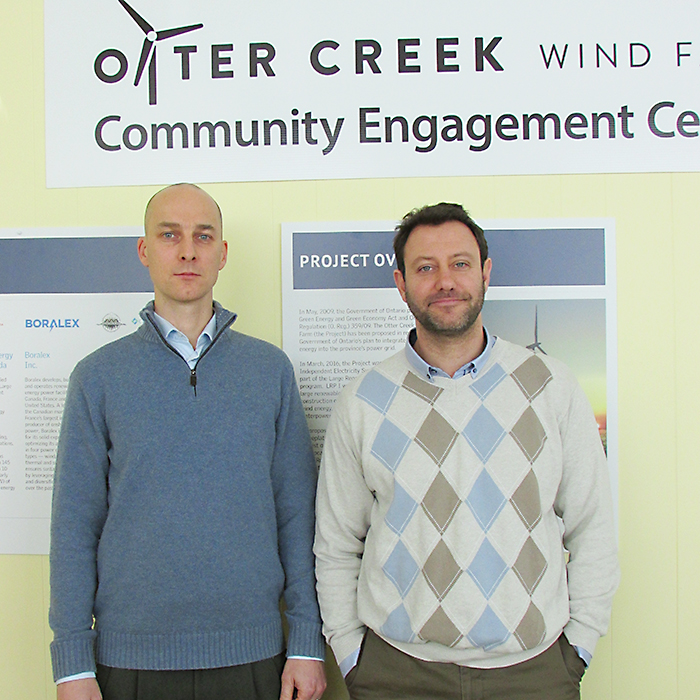
Boralex, one of the partners in the Otter Creek Wind Farm project north of Wallaceburg, says it is listening to the concerns from the community as it works toward a Renewable Energy Approval (REA) from the province.
At a technical briefing held for media on Monday afternoon, Otter Creek project manager Marc Weatherill and director of development Adam Rosso were at the Community Engagement Centre in Wallaceburg to update the project.
Monday was to be the second public meeting in Wallaceburg regarding the project, which proposes to construct 12 large turbines with a height from base to tip of 195.7 metres (641.9 feet), with a setback of 550 metres from any property. The concrete foundation is proposed to be up to 30 metres in diameter.
Rosso said the size of the turbines was decided after Boralex heard concerns about the number of turbines proposed originally.
“Initially, 17-20 turbines were anticipated, but we wanted to reduce the number of turbines after we heard concerns at the first public meeting,” Rosso said. “There will be less turbines but they will produce more power of up to 4.2 megawatts. We want to reduce all the impacts on the environment. The higher you go, the smoother the wind and with less rotational speed will be less noise.”
When asked about the issues the local group Water Wells First has over vibrations from turbines causing turbidity of area wells, Weatherill said they have met with WWF on two different occasions and if WWF can produce scientific evidence regarding their claims, they would be happy to see if it can be taken into consideration.
“We want to understand their concern and issues, but we need to see it laid out for us. That’s the reason we asked for any evidence they might have, but we haven’t seen anything like that,” Weatherill said. “A lot of what they are claiming is based on anecdotal evidence or experience and we take that seriously. But at the end of the day, we need to rely on data and facts and science and we haven’t seen that from Water Wells First yet, but if they can supply that evidence to us, we would be grateful; we would happily review that.”
Weatherill said a review of the Golder report, used by North Kent Wind 1 to refute the claim that vibration was causing water well contamination, is currently underway.
“Yes, we have done some geological studies and we’re going to be doing more, but the purpose of those studies is primarily for us to understand what’s under the ground so we can design our foundations and that will be contributing to the work we’re doing trying to identify our designs,” Weatherill said. “We are working with a third-party engineering firm, GHD Consulting, who are advising us on the claims that Water Wells First are making; on whether it is possible for vibrations from construction and/or operation can lead to increased turbidity in well water and that is something that’s ongoing, but we’ve got preliminary review from them of the Golder report, used by North Kent Wind. Basically they’ve said the Golder report is viable as far as its methodology, as far as the assumptions they’ve made and that it is also applicable to Otter Creek Wind Farm, simply because we’re not very far away.”
Rosso said the analysis that Golder went through “is to say, ‘Look, is there enough vibration from a turbine to cause the effects that people are seeing in their wells?’ and they provide a professional engineering and scientific opinion about it, based on methodology and mathematics that are well understood in science.
“The fact we’re doing a desktop study versus a field study is really up to the engineers and expert people to tell us if that is equivalent enough.”
Rosso said they have also listened to concerns about the pile driving method used to anchor the concrete bases in place and they are working with their experts and the latest technology to look at alternate methods with the least harm to the environment.
Boralex will submit the REA application to the province in two to three weeks with a targeted approval for fall of 2017. If they get the REA, construction would begin in 2018 and commissioning in 2019.






